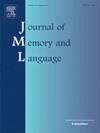Serial position effects in spoken word production are determined by previous context: Evidence from aphasia
IF 3
1区 心理学
Q1 LINGUISTICS
引用次数: 0
Abstract
Organising and producing a sequence of events is a basic human cognitive capacity. It occurs across a wide variety of domains including speech, writing, memory, planning and almost every type of skilled action. Errors involving sequences have been widely studied and often present two kinds of profiles: performance either declines across positions or it declines and then improves in the final positions (a U-shaped pattern). Studies of errors in aphasia have also reported these patterns with letters (in spelling) or phonemes (in speech). Another pattern, with more difficulty initiating speech, has been reported in apraxia of speech. Contrasting declines and increases in performance, however, have not been described in studies using the same methodology and evidence of performance linearly improving is very limited. We document all three patterns using statistical models in a case series of 23 people with aphasia (PwA) who make speech errors when repeating single words. We found that the declining pattern and the U-shape patterns occurred across patients, independent of whether their main impairment was a phonological impairment or apraxia of speech. Only people with apraxia of speech, however, showed the inverse pattern of linearly improving performance. Upward and downward patterns were not the consequence of a general factor like severity. Importantly, further exploration with statistical models revealed that phoneme position in the word was not, in fact, the dominant factor determining the visual patterns. Instead, performance was determined by either the number of previous errors (for declining performance) or the number of previous phonemes correct (for improving performance). Errors were almost never governed by serial position or word length per se. Our results support an important role for evolving context in the serial production mechanisms supporting single word production and we discuss implications for current models of speech production and, more generally, for models of serial performance. We suggest that temporary retention of novel sequences may rely more on an explicit representation of position, while stored articulatory representations may benefit from a contextual format (of the chaining type) where activation of previous units helps to support retrieval of units further along in the sequence.
口语单词产生中的连续位置效应是由先前的语境决定的:来自失语症的证据
组织和产生一系列事件是人类的基本认知能力。它发生在各种各样的领域,包括说话、写作、记忆、计划和几乎所有类型的熟练动作。涉及序列的错误已经得到了广泛的研究,并且通常呈现两种类型的特征:性能要么在各个位置下降,要么在最终位置下降然后提高(u形模式)。对失语症中的错误的研究也报告了这些模式与字母(拼写)或音素(说话)。另一种模式是在言语失用症中,难以开口说话。然而,在使用相同方法的研究中,并没有描述性能下降和增加的对比,并且性能线性提高的证据非常有限。我们用统计模型记录了23名在重复单个单词时出现语音错误的失语症患者的病例序列。我们发现下降模式和u型模式发生在所有患者身上,与他们的主要障碍是语音障碍还是言语失用无关。然而,只有患有语言失用症的人表现出相反的线性改善模式。上升和下降的模式并不是严重程度等一般因素的结果。重要的是,统计模型的进一步研究表明,事实上,音素在单词中的位置并不是决定视觉模式的主要因素。相反,性能取决于先前错误的数量(用于降低性能)或先前正确的音素的数量(用于提高性能)。错误几乎从不由序列位置或字长本身决定。我们的研究结果支持上下文在支持单字生成的连续生成机制中发挥重要作用,并讨论了对当前语音生成模型的影响,更一般地说,对连续性能模型的影响。我们认为,新序列的临时保留可能更多地依赖于位置的明确表示,而存储的发音表示可能受益于上下文格式(链式),其中先前单元的激活有助于支持序列中进一步单元的检索。
本文章由计算机程序翻译,如有差异,请以英文原文为准。
求助全文
约1分钟内获得全文
求助全文
来源期刊
CiteScore
8.70
自引率
14.00%
发文量
49
审稿时长
12.7 weeks
期刊介绍:
Articles in the Journal of Memory and Language contribute to the formulation of scientific issues and theories in the areas of memory, language comprehension and production, and cognitive processes. Special emphasis is given to research articles that provide new theoretical insights based on a carefully laid empirical foundation. The journal generally favors articles that provide multiple experiments. In addition, significant theoretical papers without new experimental findings may be published.
The Journal of Memory and Language is a valuable tool for cognitive scientists, including psychologists, linguists, and others interested in memory and learning, language, reading, and speech.
Research Areas include:
• Topics that illuminate aspects of memory or language processing
• Linguistics
• Neuropsychology.

 求助内容:
求助内容: 应助结果提醒方式:
应助结果提醒方式:


